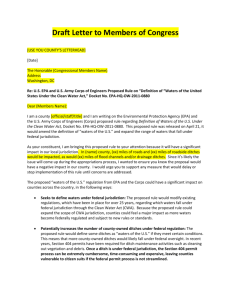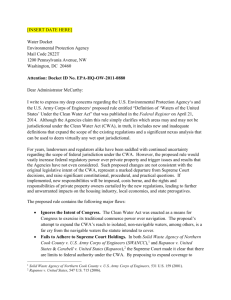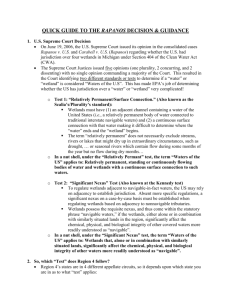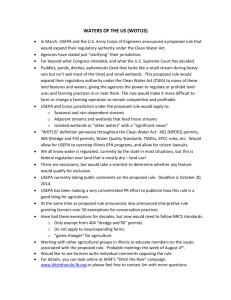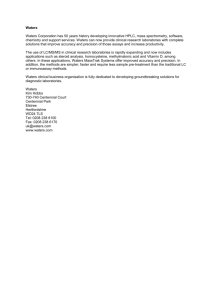BNA Insights: Interpreting 'Water of the United
advertisement
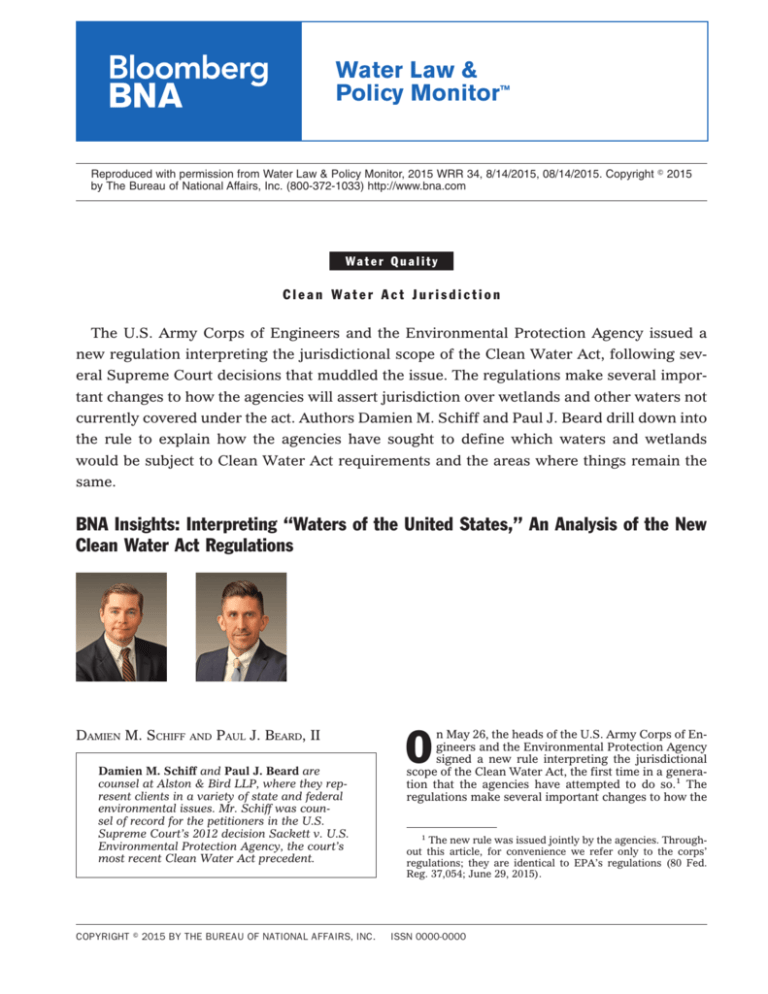
Water Law & Policy Monitor™ Reproduced with permission from Water Law & Policy Monitor, 2015 WRR 34, 8/14/2015, 08/14/2015. Copyright 姝 2015 by The Bureau of National Affairs, Inc. (800-372-1033) http://www.bna.com Wa t e r Q u a l i t y Clean Water Act Jurisdiction The U.S. Army Corps of Engineers and the Environmental Protection Agency issued a new regulation interpreting the jurisdictional scope of the Clean Water Act, following several Supreme Court decisions that muddled the issue. The regulations make several important changes to how the agencies will assert jurisdiction over wetlands and other waters not currently covered under the act. Authors Damien M. Schiff and Paul J. Beard drill down into the rule to explain how the agencies have sought to define which waters and wetlands would be subject to Clean Water Act requirements and the areas where things remain the same. BNA Insights: Interpreting ‘‘Waters of the United States,’’ An Analysis of the New Clean Water Act Regulations DAMIEN M. SCHIFF AND PAUL J. BEARD, II Damien M. Schiff and Paul J. Beard are counsel at Alston & Bird LLP, where they represent clients in a variety of state and federal environmental issues. Mr. Schiff was counsel of record for the petitioners in the U.S. Supreme Court’s 2012 decision Sackett v. U.S. Environmental Protection Agency, the court’s most recent Clean Water Act precedent. COPYRIGHT 姝 2015 BY THE BUREAU OF NATIONAL AFFAIRS, INC. n May 26, the heads of the U.S. Army Corps of Engineers and the Environmental Protection Agency signed a new rule interpreting the jurisdictional scope of the Clean Water Act, the first time in a generation that the agencies have attempted to do so.1 The regulations make several important changes to how the O 1 The new rule was issued jointly by the agencies. Throughout this article, for convenience we refer only to the corps’ regulations; they are identical to EPA’s regulations (80 Fed. Reg. 37,054; June 29, 2015). ISSN 0000-0000 2 agencies will assert jurisdiction over wetlands and other waters not currently covered under the act. The authors drill down into the rule to explain how the agencies have sought to define which waters and wetlands would be subject to Clean Water Act requirements and the areas where things remain the same. More than 30 states and 20 organizations representing agriculture, industry and mining interests have challenged the rulemaking on the grounds that it amounts to regulatory overreach and would cause economic harm. Several environmental organizations have also sued over the rule, saying it weakens some protections and does not adequately protect certain large iconic waters (2015 WLPM, 7/30/15). The regulations substantially rework how the act will apply to wetlands and certain other water features, while reaffirming prior regulations’ expansive assertion of authority over most rivers, lakes, streams, and creeks. They significantly expand the number— although perhaps not the on-the-ground impact—of jurisdictional exceptions and define several important terms. 1972 Clean Water Act Amendments The Federal Water Pollution Control Act Amendments of 1972,2 commonly known as the Clean Water Act, make it unlawful to discharge without a permit any pollutant into ‘‘navigable waters,’’ which the act defines as the ‘‘waters of the United States.’’ Shortly after the law’s passage, the agencies promulgated regulations interpreting those waters to mean waters that are navigable-in-fact.3 An environmental group successfully challenged that interpretation as too narrow.4 Thereafter, the agencies promulgated regulations that have until now remained largely unchanged.5 Under these regulations, waters of the U.S. included, in addition to navigable-in-fact and interstate waters, all tributaries of such waters, all wetlands adjacent to such waters and tributaries, and certain waters, the use or degradation of which could affect interstate commerce.6 The U.S. Supreme Court has had three occasions to interpret ‘‘waters of the United States.’’ In United States v. Riverside Bayview Homes,7 it upheld the assertion of jurisdiction over wetlands adjacent to navigable-in-fact waters. In Solid Waste Agency of Northern Cook County (SWANCC) v. U.S. Army Corps of Engineers,8 the court rejected the agencies’ assertion of authority over ponded gravel mining pits that had no connection to navigable waters other than that they provided habitat for migratory birds. Finally, in Rapanos v. United States,9 the court (in a fractured opinion) overturned the lower courts’ acceptance of the agencies’ ‘‘hydrological connection’’ theory, whereby Clean Water Act jurisdiction would attach to any water or wetland from which water could flow and ultimately reach a 2 33 U.S.C. §§ 1251-1388. See 39 Fed. Reg. 12,115, 12,119 (Apr. 3, 1974). NRDC v. Callaway, 392 F. Supp. 685 (D.D.C. 1975). 5 See 42 Fed. Reg. 37,122, 37,124, 37,144 (July 19, 1977); 47 Fed. Reg. 31,794, 31,810-11 (July 22, 1982); 51 Fed. Reg. 41,206, 41,216-17 (Nov. 13, 1986). 6 33 C.F.R. § 328.3(a) (2014). 7 474 U.S. 121 (1985). 8 531 U.S. 159 (2001). 9 547 U.S. 715 (2006). 3 4 8-14-15 navigable-in-fact water. The court could not, however, produce a single rationale explaining the rejection of the agencies’ theory. A four-justice plurality led by Justice Antonin Scalia argued that the act cannot extend to ephemeral streams or ditches and cannot cover wetlands that are clearly separated from neighboring jurisdictional waters. Justice Anthony Kennedy, concurring in the judgment and writing only for himself, concluded that Justice Scalia’s approach was insufficiently solicitous of Congress’ water quality goals. For him, the appropriate test should be whether the water or wetland bears a ‘‘significant nexus’’ to a navigable-in-fact water, i.e., significantly affects the chemical, physical, and biological integrity of that downstream water.10 Differences of New Rule From Prior Law The new rule differs from prior law in three main respects. First, it significantly expands (as compared to the agencies’ practice post-Rapanos) the scope of the agencies’ jurisdiction under the act. Second, it adds a number of categorical exclusions to jurisdiction. Third, it defines several pre-existing and new terms. These changes, described in greater detail below, will have a significant impact on how the act is administered and the types of activities that fall within its scope. For example, under the new rule, every tributary of navigable waters—whether natural or manmade, whether a gushing torrent or a trickling rivulet—is presumptively jurisdictional. Combined with the new rule’s capacious definitions of ‘‘tributary,’’ ‘‘adjacent’’ and ‘‘neighboring,’’ there will be few aquatic features for which a plausible argument for jurisdiction cannot be essayed. Further, the rule’s enigmatic jurisdictional exceptions, many of which turn on new and undefined terms, fail to provide any real regulatory certainty to a landowner or other project proponent seeking to determine the jurisdictional status of a wetland or other aquatic feature. Changes in Jurisdictional Scope. The jurisdictional scope of the act is expanded with respect to ‘‘tributary,’’ ‘‘adjacency’’ and ‘‘other waters’’ while control over many other features is retained.11 Jurisdiction over so-called ‘‘traditional navigable waters,’’ i.e., those that have served, or do or can serve, as channels of commerce, is retained in the rule.12 Similarly, the rule maintains jurisdiction over all interstate waters (including interstate wetlands), regardless of their ability to serve as channels of commerce.13 Finally, the rule continues to assert jurisdiction over any ‘‘impoundment’’ of a jurisdictional water.14 10 Id. at 779 (Kennedy, J., concurring in the judgment) (citing 33 U.S.C. § 1251(a)). 11 We use the term ‘‘jurisdictional’’ as a tool of convenience, recognizing that the characterization is not legally significant. See City of Arlington v. FCC, 133 S. Ct. 1863, 1870-71 (2013) (‘‘[J]udges should not waste their time in the mental acrobatics needed to decide whether an agency’s interpretation of a statutory provision is ‘jurisdictional’ or ‘nonjurisdictional.’ . . . [T]he question in every case is, simply, whether the statutory text forecloses the agency’s assertion of authority, or not.’’). 12 33 C.F.R. § 328.3(a)(1), (3) (2015). For convenience, we include ‘‘territorial seas’’ within the category of traditional navigable waters. 13 Id. § 328.3(a)(2). 14 Id. § 328.3(a)(4). COPYRIGHT 姝 2015 BY THE BUREAU OF NATIONAL AFFAIRS, INC. WRRN ISSN 0000-0000 3 Tributary Jurisdiction. The rule asserts jurisdiction over all tributaries, regardless of flow or distance from a navigable-in-fact water or any other qualitative relationship between the tributary and the downstream water.15 Although the prior regulation on its face also asserted jurisdiction over all tributaries, that regulation was not enforceable as written, following Rapanos. Scalia’s plurality opinion in Rapanos concludes that the Clean Water Act cannot be interpreted to cover ‘‘channels through which water flows intermittently or ephemerally, or channels that periodically provide drainage for rainfall.’’16 Rather, the act permits the regulation of tributaries only to the extent that they are ‘‘relatively permanent, standing or continuously flowing bodies of water’’ that are described in ‘‘ordinary parlance’’ as streams.17 Kennedy’s concurring opinion in Rapanos differs from the plurality opinion in its emphasis of the ‘‘significant nexus’’ concept. Nevertheless, the opinion rejects an ‘‘all tributaries are jurisdictional’’ interpretation of the act. Rather, it states that the aforementioned ‘‘standard for tributaries . . . provides no . . . assurance’’ that only waters bearing such a significant nexus will fall within the regulation’s scope. The opinion suggests that this defect could be remedied through ‘‘regulations or adjudication, [whereby the agencies] may choose to identify categories of [jurisdictional] tributaries [based on] their volume of flow . . . , their proximity to navigable waters, or other relevant considerations.’’18 But in the absence of such regulations, the opinion concludes that the agencies ‘‘must establish a significant nexus on a case-by-case basis.’’19 The new regulations, however, definitively presume that all tributaries, regardless of the factors discussed in Kennedy’s concurring opinion, bear the requisite significant nexus and thus are jurisdictional.20 Hence, the new rule expands tributary jurisdiction. That expansion is all the more significant given, as discussed below, the new rule’s broad definition of what constitutes a ‘‘tributary.’’ Adjacency Jurisdiction. Prior rules asserted jurisdiction over wetlands adjacent to other jurisdictional waters, except other wetlands.21 Thus, jurisdiction did not extend to wetlands for which the only adjacent waters were other wetlands.22 Similarly, jurisdiction did not extend to non-wetland waters (such as ponds) that happen to be adjacent to jurisdictional waters.23 In contrast, under the new rule adjacency jurisdiction is ex15 Id. § 328.3(a)(5). Rapanos, 547 U.S. at 739 (plurality op.). 17 Id. 18 Id. at 780-81 (Kennedy, J., concurring in the judgment). 19 Id. at 782. It is true that Kennedy made these observations in the context of adjacent wetlands, not tributaries. But the new rule takes the position that Justice Kennedy’s opinion should be read as supplying a jurisdictional standard for all waters. 80 Fed. Reg. at 37,061. 20 80 Fed. Reg. 37068-69, 37,076. 21 See 33 C.F.R. § 328.3(a)(7) (2014). 22 See Great Northwest, Inc. v. U.S. Army Corps of Eng’rs, No. 4:09-cv-0029-RRB (D. Alaska June 8, 2010) (determining that wetlands adjacent to other wetlands are not jurisdictional). 23 See San Francisco Baykeeper v. Cargill Salt. Div., 481 F.3d 700, 705 (9th Cir. 2007) (holding that salt ponds were not jurisdictional notwithstanding their adjacency to jurisdictional waters). 16 WATER LAW & POLICY MONITOR ISSN 0000-0000 tended to all waters.24 Moreover, the new rule eliminates the former exclusion of wetlands adjacent to other wetlands25 and thus embodies a substantial expansion of adjacency jurisdiction, well beyond what the case law hitherto has approved. ‘Other Waters’ Jurisdiction. Prior to the new rule, jurisdiction could be asserted over those waters otherwise not covered if the use or degradation of those waters could affect interstate commerce.26 In contrast, the new rule eliminates entirely the commerce connection for waters that do not themselves serve as channels of commerce.27 In its place are two new provisions for nonadjacent wetlands and other waters. These provisions may capture, on a case-by-case basis, many of the waters that would have been subject to jurisdiction under the old commerce-dependent standard. First, the rule sets forth a special provision for certain regional wetlands—namely, prairie potholes, Carolina and Delmarva bays, pocosins, western vernal pools and Texas coastal prairie wetlands.28 For these wetlands, the agencies will assert jurisdiction, case-by-case, depending on whether any of them have a significant nexus to a traditional navigable water. In making that determination, the agencies will aggregate all other ‘‘specialty’’ wetlands within the same watershed of the nearest traditional navigable water. Moreover, the agencies will assert jurisdiction over these wetlands, notwithstanding a lack of adjacency to other jurisdictional waters.29 This provision of the new rule therefore differs from the agencies’ past practice in that, previously, the agencies did not differentiate among wetlands types,30 nor generally did they assert jurisdiction over non-adjacent wetlands.31 Second, the rule sets forth a jurisdictional catch-all for all other waters. Under this new provision, a water will be considered jurisdictional if it is bears a significant nexus to a traditional navigable or interstate water, and if it is located (i) within the 100-year flood plain of a traditional navigable water or other interstate water, or (ii) within 4,000 feet of the high tide line or ordinary high water mark of a jurisdictional (non-wetland) water.32 In contrast to the standard for specialty wetlands, the catch-all provision for other waters does not require (although it does authorize) the aggregation of similarly situated waters in determining whether a significant nexus exists. Arguably, this new ‘‘other waters’’ provision will not result in much on-the-ground change to how the agencies interpret and apply the act. Following SWANCC, the agencies were generally loathe to base jurisdiction on the prior regulation’s catchall Commerce Clause provision. Thus, one might conclude that the new rule’s replacement of that provision probably will not lead to a significant alteration of agency practice. Yet the new 24 See 33 C.F.R. § 328.3(a)(6) (2015). See also 80 Fed. Reg. 37,069. 25 See 80 Fed. Reg. 37,083. 26 See 33 C.F.R. § 328.3(a)(3) (2014). 27 See 80 Fed. Reg. 37,083-84. 28 See 33 C.F.R. § 328.3(a)(7) (2015). 29 Id. 30 See 33 C.F.R. § 328.3(a)(7) (2014). 31 See Clean Water Act Jurisdiction Following the U.S. Supreme Court’s Decision in Rapanos v. United States & Carabell v. United States 1 (Dec. 2, 2008). 32 See 33 C.F.R. § 328.3(a)(7), (8) (2014). BNA 8-14-15 4 rule’s ‘‘other waters’’ catchall provision, despite abandoning its predecessor’s Commerce Clause dependency, is ambitious in its scope. To be sure, the provision is superficially narrower than the agencies’ postRapanos practice in that the new rule imposes a geographic as well as a significant nexus standard. But the rule’s demand for propinquity can be satisfied so long as the water is, for example, within 4,000 feet of any jurisdictional tributary. In light of the new rule’s broad assertion of tributary jurisdiction, it will be the rare instance when a wetland with a significant nexus— again, as broadly understood by the new rule—is not within 4,000 feet of a covered tributary. Moreover, geographic closeness already plays, practically speaking, a large role in the significant nexus analysis. It would be the very rara aqua that satisfied the significant nexus standard but not the new rule’s propinquity requirement. Given the agencies’ evident belief that the new ‘‘other waters’’ provision avoids the former provision’s SWANCC errors, and given the new rule’s capacious understanding of other aspects of jurisdiction, it is very likely that the regulated public will see an aggressive assertion of federal control over features that, for almost two decades, commonly have been considered to be beyond the act’s scope. Jurisdictional Exceptions The former rule provided three exceptions to jurisdiction: wetlands adjacent to other wetlands, prior converted croplands, and waste treatment systems.33 The new rule retains the latter two exceptions34 and adds several others. The Ditch Exclusion. A somewhat complicated exclusion for ditches is established in the rule.35 The rule does not define ‘‘ditch’’ and arguably some features that might in common parlance be considered ditches, the agencies may deem to be non-excludable tributaries.36 Based on the wording of the exclusions, whether a ditch is a ‘‘ditch’’ is largely a function of how it came to be, i.e., a wholly manmade conveyance of water is undoubtedly a ‘‘ditch’’ for purposes of the ditch exclusion, but some ditches that rely in part on pre-existing natural features may not be. In any event, a ‘‘ditch’’ is excluded from jurisdiction if it is not hydrologically connected, i.e., provides no direct or indirect flow, to a traditional navigable water or interstate water.37 For those ditches that are hydrologically connected to traditional navigable waters or interstate waters, the rule provides a two-part exclusion based on the characterization of the ditch’s flow. A hydrologically connected ditch that flows ephemerally is excluded from jurisdiction if, but only if, it has not been excavated in a tributary and is not a relocated tributary.38 Similarly, a hydrologically connected ditch that flows intermittently is excluded from jurisdiction if, but only if, it meets the 33 33 C.F.R. § 328.3(a)(8) (2014). 33 C.F.R. § 328.3(b)(1)-(2) (2015). See 80 Fed. Reg. 37,059. 35 See 33 C.F.R. § 328.3(b)(3) (2015). 36 80 Fed. Reg. 37,098 (noting that a stream or river ‘‘altered or modified for purposes as flood control, erosion control, and other reasons’’ resulting in its being ‘‘channelized or straightened’’ is not a ditch). 37 33 C.F.R. § 328.3(b)(3)(i) (2015). 38 Id. § 328.3(b)(3)(i). 34 8-14-15 preceding conditions for a ditch with ephemeral flow and does not drain wetlands.39 The rule does not define ‘‘ephemeral’’ or ‘‘intermittent.’’40 However, its preamble explains that intermittent flow is ‘‘continuous only during certain times of the year (e.g., during certain seasons such as the rainy season),’’ whereas ephemeral flow is flow that occurs ‘‘only in response to precipitation events in a typical year.’’41 Regulated parties should bear in mind, however, that disposal of pollutants in an excluded ‘‘ditch’’ may still trigger liability: a non-jurisdictional ditch may nevertheless qualify as a ‘‘point source,’’42 and thus subject a discharger to liability if the ditch carries a pollutant to a jurisdictional water.43 For example, a ditch that may qualify for the new rule’s ‘‘intermittent’’ flow exemption may still be effectively ‘‘off limits’’ to unpermitted discharges. After all, such a ditch is, by definition, connected to regulated waters, and its intermittent flow may well be substantial enough to carry any pollutants to those waters, thus triggering liability. Similarly, although the new rule excludes groundwater from regulation, such an exclusion may mean little if pollutants discharged to groundwater ultimately end up in covered waters.44 Exclusions Codifying Agency Practice. The new rule excludes a number of features that, generally speaking, the agencies have never claimed as part of their Clean Water Act jurisdiction. These features include artificially irrigated areas that otherwise would be dry land;45 manmade lakes, ponds,46 reflecting and swimming pools; ornamental waters; depressions incidental to mining or construction activity; stormwater control features and wastewater recycling structures, all of which are built in dry land; puddles47 and groundwater.48 Many of the foregoing exclusions require that the feature be located in ‘‘dry land,’’ a term that the rule does not define. Although the preamble provides that ‘‘dry land’’ ‘‘refers to areas of the geographic landscape that are not water features such as streams, rivers, wetlands, lakes, ponds and the like,’’ it also cautions that land is not ‘‘dry’’ simply because it is not always wet, and that ‘‘further clarity on this issue can be provided during implementation.’’49 Therefore, a prudent property owner would do well, in the absence of further guidance from the agencies, to interpret ‘‘dry land’’ to 39 Id. § 328.3(b)(3)(ii). 80 Fed. Reg. 37,076. 41 Id. 42 See id. at 37,098; 33 U.S.C. § 1362(14) (defining ‘‘point source’’ to include ‘‘ditch’’). 43 See Rapanos, 547 U.S. at 735-36 (plurality op.). 44 In Northern California River Watch v. City of Healdsburg, 496 F.3d 993 (9th Cir. 2007), a post-Rapanos decision, the Ninth Circuit found a significant nexus based in part on subsurface hydraulic connections between a pond and the nearby Russian River. Id. at 1000. 45 The preamble cautions that a feature is not necessarily excluded simply because it is irrigated. 80 Fed. Reg. 37,099. 46 Nevertheless, the preamble states that some ponds, although not themselves ‘‘waters of the United States,’’ can trigger liability as ‘‘point sources.’’ Id. 47 The rule does not define ‘‘puddle,’’ but the preamble provides that a puddle is ‘‘a very small, shallow, and highly transitory pool of water that forms on pavement or uplands during or immediately after a rainstorm or similar precipitation event.’’ Id. 48 33 C.F.R. § 328.3(b)(4) (2015). 49 80 Fed. Reg. 37,098-99. 40 COPYRIGHT 姝 2015 BY THE BUREAU OF NATIONAL AFFAIRS, INC. WRRN ISSN 0000-0000 5 mean an area not already subject to jurisdiction under the rule. The rule also excludes certain ‘‘[e]rosional features.’’ Such features are excluded if they do not otherwise qualify as tributaries or wetlands, or if they are lawfully constructed grassed waterways.50 New Definitions Under the old regulations, very few significant terms were defined. The new rule, however, defines some old terms as well as new terms (although many other key terms in the rule, such as ‘‘water,’’ ‘‘intermittent,’’ ‘‘ephemeral,’’ ‘‘ditch,’’ and ‘‘dry land,’’ are left undefined in the rule itself). Tributary. The new rule defines for the first time the longstanding regulatory term ‘‘tributary.’’ A tributary must: (i) be a ‘‘water’’; (ii) flow (directly or indirectly) to a traditional navigable water or other interstate water; (iii) have physical indicators of a bed and banks; and (iv) have physical indicators of an ordinary high water mark.51 Thus, a feature qualifies as a ‘‘tributary’’ even if it is manmade, is segmented by ‘‘natural breaks,’’ or flows through a non-jurisdictional feature.52 Moreover, so long as the aforementioned physical features are present, the tributary is jurisdictional, regardless of the actual quantity or quality of flow.53 Hence, under the new rule a prudent landowner or project proponent should never assume, without a thorough professional analysis—-and perhaps agency involvement—-that a feature is not jurisdictional simply because it ‘‘rarely’’ contains water, or is miles from a navigable-in-fact water. Adjacent. The former regulations defined ‘‘adjacent’’ to mean bordering, contiguous, or neighboring.54 The new rule retains this basic definition, but provides additional meaning. To begin with, the rule expressly provides that any wetland within or abutting the ordinary high water mark of a jurisdictional pond or lake is adjacent, and that adjacency is not limited to ‘‘laterally’’ situated waters.55 The preamble explains that these provisions are meant to capture ponds that serve as the source of a tributary, as well as any wetlands that may abut those ponds.56 Further, the rule for the first time defines the constituent term ‘‘neighboring.’’ A water is neighboring (and thus adjacent) if any of the following are true: (i) some portion of the water lies within 100 feet of the ordinary high water mark of a traditional navigable water, 50 33 C.F.R. § 328.3(b)(4)(vi) (2015). The agencies’ Rapanos Guidance provided that such features ‘‘generally’’ would not be subject to jurisdiction. Guidance at 1. 51 33 C.F.R. § 328.3(c)(3) (2015). The preamble goes into some detail to explain how elements (ii) through (iv) can be established. See 80 Fed. Reg. at 37,076-77. Note that the Corps’ existing regulations already define ‘‘ordinary high water mark.’’ Id. § 328.3(e) (2014). The new rule adds that definition to EPA’s regulations. 52 See 33 C.F.R. § 328.3(c)(3) (2015). See also 80 Fed. Reg. at 37,078. 53 80 Fed. Reg. at 37,076. 54 33 C.F.R. § 328.3(c) (2014). 55 33 C.F.R. § 328.3(c)(1) (2015). 56 80 Fed. Reg. at 37,080. WATER LAW & POLICY MONITOR ISSN 0000-0000 an interstate water, a tributary, or any impoundment of a jurisdictional water; (ii) some portion of the water lies within the 100-year flood plain of a traditional navigable water, an interstate water, a tributary, or any impoundment of a jurisdictional water, and within 1,500 feet of the ordinary high water mark of the same; (iii) some portion of the water lies within 1,500 feet of the high tide line57 of a traditional navigable water; or (iv) some portion of the water lies within 1,500 feet of the ordinary high water mark of one of the Great Lakes.58 The preamble elaborates that some wetland matrices may be considered a single, adjacent (and thus jurisdictional) water so long as some portion qualifies as ‘‘neighboring,’’ notwithstanding that the matrix contains ‘‘non-wetland components.’’59 Given these definitions, it is exceedingly unlikely that the agencies would decline to exercise jurisdiction over waters solely because they are not continuous. For example, that a wetland may be too far from a traditional navigable water or tributary to qualify as an adjacent water does not mean that the wetland will be excluded from jurisdiction. If the wetland is separated from the nearest tributary by a series of wetlands and uplands, the agencies may well conclude that all the wetlands, even those that on their own would be non-adjacent, are jurisdictional because they form a single, adjacent wetland matrix. Significant Nexus. The rule defines ‘‘significant nexus,’’ a term that does not come not from the statute or any prior regulation. It was first used in passing in SWANCC60 and then discussed extensively in Kennedy’s Rapanos concurrence.61 The rule provides that a significant nexus exists between a water or wetland and a traditional navigable water or interstate water if that water or wetland, on its own or in combination with similarly situated waters or wetlands ‘‘in the region,’’ significantly affects the chemical, physical, or biological integrity of the traditional navigable water or interstate water.62 The rule defines the constituent phrase ‘‘in the region’’ to mean the watershed that drains to the nearest traditional navigable water or interstate water. The rule explains that a significant nexus is present if any one of the following functions of the water or wetland (or similarly situated waters or wetlands) contributes significantly to the chemical, physical, or biological integrity of the nearest traditional navigable water or interstate water: sediment trapping; nutrient recycling; pollutant trapping, transformation, filtering, and transport; retention and attenuation of flood waters; runoff storage; contribution of flow; export of organic matter; export of food resources and provision of life cycle dependent aquatic habitat for a species dwelling within a traditional navigable water or interstate water.63 57 The Corps’ existing regulations already define ‘‘high tide line.’’ 33 C.F.R. § 328.3(d) (2014). The new rule adds that definition to EPA’s regulations. 58 33 C.F.R. § 328.3(c)(2) (2015). 59 80 Fed. Reg. at 37,081. 60 See SWANCC, 531 U.S. at 167. 61 Cf. Rapanos, 547 U.S. at 755 (plurality op.) (observing that ‘‘significant nexus’’ ‘‘appears nowhere in the Act, but is taken from SWANCC’s cryptic characterization of the holding of Riverside Bayview’’). 62 33 C.F.R. § 328.3(c)(5) (2015). 63 33 C.F.R. § 328.3(c)(5)(i)-(ix). BNA 8-14-15 6 The definition of ‘‘significant nexus’’ is generally consistent with the agencies’ post-Rapanos practice.64 It differs, however, in one important respect from how Kennedy defined it. Specifically, he defined the term with respect to impacts on the chemical, physical, and biological integrity of traditional navigable waters. In contrast, the rule defines the term in the disjunctive. The rule’s preamble defends the switch not by reference to Kennedy’s opinion but rather to the statutory ‘‘objective,’’ which the agencies contend would be ‘‘subvert[ed]’’ if the Act ‘‘only protected waters upon a showing that they had effects on every attribute of the integrity’’ of a traditional navigable water or interstate water.65 Although the agencies’ reasoning may be plausible, the new definition of significant nexus remains difficult to reconcile with Kennedy’s opinion. After all, not only does that opinion use the conjunctive rather than the disjunctive, it explains the significant nexus test solely in relation to wetlands.66 That limited application should not be overlooked, given the opinion’s extended discussion (and rejection) of the then-current standard for tributary jurisdiction.67 Importantly, it is not altogether clear whether or to what extent the agencies’ interpretation of this obscure term is entitled to deference, which normally is extended to agency interpretation of statutory or regulatory text, not judicial opinions.68 Jurisdiction Question to Persist The new Clean Water Act rule substantially reworks how the agencies will approach their authority to regulate wetlands and other non-navigable waters. It provides the regulated public some measure of clarity, in terms of the types of waters that are categorically jurisdictional, as well as the types of features that are cat64 See Guidance at 10-11. 80 Fed. Reg. at 37,067. 66 See Rapanos, 547 U.S. at 782 (Kennedy, J., concurring in the judgment). 67 Id. at 780-81. 68 See Chevron U.S.A., Inc. v. NRDC, 467 U.S. 837 (1984); Auer v. Robbins, 519 U.S. 452 (1997). 65 8-14-15 egorically excluded from jurisdiction. It would be a mistake, however, to construe this additional clarity as necessarily a boon to the regulated public. Much of the rule’s clarity derives from its categorical regulation of wetlands and other features that, following Rapanos, many property owners (as well as some agency officials) considered non-jurisdictional. Moreover, many of the rule’s categorical exclusions (such as puddles and swimming pools) seem to be included in the rule more as a PR tool to blunt criticism of the expansive scope of the rule’s jurisdictional component, rather than as a sincere attempt by the agencies to adopt a more modest view of their regulatory authority. Finally, it would be difficult to justify (and the rule’s preamble does not even attempt to justify) the rule under the Rapanos plurality opinion. The legality of the new rule therefore will depend upon how faithfully the agencies have interpreted Kennedy’s views, a task which has befuddled court watchers and legal experts in many areas of the law. Legal challenges to the rule from all sectors of the regulated community continue to pour in. Not surprisingly, these lawsuits challenge the rule’s broad assertion of jurisdiction over tributaries, adjacent waters and non-adjacent ‘‘other waters.’’ The lawsuits contend that the rule converts the act into a federal land-use law, thereby subverting the federal-state balance guaranteed by the Tenth Amendment, as well as the purpose undergirding the enumeration of powers contained within Article I of the United States Constitution. In addition to the constitutional argument, the lawsuits contend that the new rule contravenes the outer jurisdictional boundaries that SWANCC and Rapanos establish. Finally, the lawsuits assert that the agencies’ last-minute attempts to cabin the rule’s scope (through, for example, the addition of the propinquity requirement for ‘‘other waters’’ jurisdiction), perversely exacerbate the rule’s illegality by resulting in an impermissible deviation from the proposed rule. Whatever the precise legal merits of the specific legal arguments raised by these lawsuits, their basic theme of federal government overreach is one that, in the last several decades, generally has found a welcome audience in the Supreme Court. It is therefore unlikely that the new rule’s jurisdictional assessment will be the last or definitive word on the Clean Water Act’s scope. COPYRIGHT 姝 2015 BY THE BUREAU OF NATIONAL AFFAIRS, INC. WRRN ISSN 0000-0000

